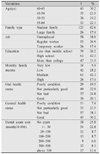Abstract
Purpose
This study was performed to identify the relationship between belief, knowledge, and practice about oral health care of middle-aged women, and to prepare baseline data for developing a dental health education and promotion program.
Method
For the survey, 120 individuals(middle-aged women) were chosen by convenience sampling and agreed to participate in the study. Their belief, knowledge, and practice about oral health care were measured. For descriptive statistics, t-test, ANOVA, Tukey and Pearson's correlation coefficient were used with SPSS Win 14.0.
Result
The level of belief and practice about oral health care was middle for the subjects. However, the level of knowledge about oral health care was relatively high. The level of practice about oral health care related to characteristics of subjects showed significant differences according to level of education and oral health status. There was no significant correlation between the level of practice and the belief about oral health care. The practice about oral health care showed a significant positive correlation with knowledge.
Figures and Tables
References
1. Choi J.S. Relationships between dental fear and dental services utilization with respect to oral health promotion. J Korean Soc Health Educ Promot. 2006. 23(4):47–65.
2. Choi J.M. A study on the level of awareness and practice of the pregnant women about the oral health care. 2005. Seoul: Chung-ang University;Unpublished master's thesis.
3. Chung Y.S. A study on the status of the Dental Health of Adults. J Korean Soc Health Educ Promot. 2000. 17(1):95–113.
4. Cohen J. Statistical power analysis for the behavioral sciences. 1988. 2nd ed. Hillsdal.
5. Jeong S.W., Kim Y.N., Riew J.I., Park W.S., Bae K.H., Bae S.M., Shin S.J. Strengthening strategies of oral health program throughout lifecycle. 2007. Gangnung: Kangnung National University.
6. Jang J.Y. The Correlation Study on Oral Health Behavior toward Oral Health Belief. Journal of korean academy of dental hygiene. 2007. 9(1):133–148.
7. Jeong S.W., Riew J.I., Jeong D.B. A study or risk factors associated with chewing problems and perceived oral health in korean adults. J Korean Acad Dent Health. 2007. 31(10):64–65.
8. Jo E.M. A study on the oral health cognition, behavior and community periodontal index of treatment needs of university students. 2001. Gwangju: Chosun University;Unpublished master's thesis.
9. Kang M.K. A study on levels of awareness of nosocomial infection and management practices by operating room nurses. 2003. Seoul: Chung-ang University;Unpublished master's thesis.
10. Kim E.J. A study on the belief and the behavior in dental health: Focused on in-hospital patients. 2001. Jukjeon: Dankook University;Unpublished master's thesis.
11. Kim J.B., Lee Y.H. A survey on family dental health behavior in seoul metropolitan city. J Korean Acad Dent Health. 1994. 18(2):526–544.
12. Kim J.B., Choi E.J., Moon H.S, et al. Public Dental Health. 2002. Seoul: Komoonsa;303–377.
13. Kim J.H., Min K.J. Research about relationship between the quality of life, oral health and total health of adults. J Korean Soc Health Educ Promot. 2008. 25(2):31–46.
14. Korean Dental Association. 98-99 weekly reports on oral health.
15. Kim S.H., Lim S.A., Park S.J., Kim D.K. Assessment oral health-related quality of life using the Oral Health Impact Profile(OHIP). J Korean Acad Dent Health. 2004. 28(4):559–568.
16. Lee J.H. A Study about relation between dental health realization and practice. 2007. Cheonan: Dankook University;Unpublished master's thesis.
17. Oh Y.B. Children's Dental Health Behavior in relation to Their Mothers' Socioeconomic Factors and Dental Health Beliefs. 1997. Iksan: Wonkwang University;Unpublished doctoral dissertation.
18. Park C.H. Dental caries of preschoolers and knowledge, cognition and behaviour of the parents. 2001. Busan: Inje University;Unpublished master's thesis.
19. Renee M.B., Robert J.G., Gregory E.W., Kathleen M.H., Maurizio T., Jean W.W. Bacterial species in Subgingival plaque and oral bone loss in postmenopausal women. J Periodontol. 2007. 78(6):1051–1061.
20. Rho E.M. A study of hospitalized patients' recognition and practice of dental health. 2007. Daegu: Catholic University of Daegu;Unpublished master's thesis.
21. Richmond S., Chestnutt I., Shennan J., Brown R. The relationship of medical and dental factors to perceived general and dental health. Community Dent Oral Epidemiol. 2007. 35(2):89–97.
22. Riew H. Study on development of Korean adults' oral-health age concept and oral health standard. 2007. Cheonan: Dankook University;Unpublished doctoral dissertation.
23. Seo E.J. A survey on Koreans' behavior about the use of oral hygiene devices. 2001. Cheonan: Dankook University;Unpublished master's thesis.
24. Song K. A study on the evaluation of health and oral health related quality if life un korean adults. 2007. Seoul: Hanyang University;Unpublished doctoral dissertation.
25. Takata Y., Maeda Y., Isoda C., Nakanishi R. Effect of the oral health-education on periodontal disease among workers before middle age. Matsushita Medical Journal. 2004. 43(1):61–65.
26. US. Dept. of health and human services. Oral health in report of the Surgeon General, 2000.
27. Ware J.E., Sherbourne C.D. The MOS 36-item short-term health survey as a health measure; the predictive value of self-reported health status on the use of physician services and on mortality in the working-age population. J Clin Epidemiol. 1997. 50(5):517–528.
28. Won J.H. Oral health perception, knowledge, and behavior among visiting health care providers. 2008. Seoul: Hanyang University;Unpublished master's thesis.




 PDF
PDF ePub
ePub Citation
Citation Print
Print









 XML Download
XML Download